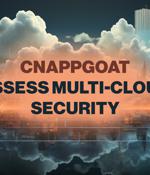Security News

"Multi-cloud computing offers huge benefits but makes IT far more complex," said Bernie Hoecker, partner, Enterprise Cloud Transformation leader, ISG. "Enterprises that have made the leap are adopting increasingly powerful tools to manage that complexity." Cloud observability platforms are increasingly essential as multi-cloud complexity increases, the report says.

With Microsoft Defender for Cloud, cloud security posture management features are now available for Google Cloud Platform, as well as AWS and Azure. Almost 90% of enterprises use more than one public cloud provider, according to Flexera's 2023 State of the Cloud survey.

With Microsoft Defender for Cloud, cloud security posture management features are now available for Google Cloud Platform, as well as AWS and Azure. Almost 90% of enterprises use more than one public cloud provider, according to Flexera's 2023 State of the Cloud survey.

Ermetic released CNAPPgoat, an open-source project that allows organizations to test their cloud security skills, processes, tools, and posture in interactive sandbox environments that are easy to deploy and destroy. CNAPPgoat supports AWS, Azure, and GCP platforms for assessing the security capabilities included in Cloud Native Application Protection Platforms.

Rather, a complex multicloud landscape requires a zero trust approach to protecting data. Functionally, zero trust in a multicloud environment is like the security protocols people encounter as they navigate airports en route to their destinations.

Due to the increasing importance of multi-cloud and the intricate nature of cloud infrastructure, obtaining a comprehensive understanding of the various cloud workloads operating within your system, and ensuring their security, can be challenging. In this Help Net Security video, Kaus Phaltankar, CEO at Caveonix discusses how in today's complex multi-cloud landscape, the role of CISOs is more crucial than ever.

Multi-cloud data storage, once merely a byproduct of the great cloud migration, has now become a strategy for data management. As ransomware attacks continue to rise at a 13% growth rate year over year, surely more cloud storage simply equals more data vulnerability gaps to fill, right? New developments in data technology address these concerns.

"Broadly speaking, digital sovereignty means having control of your digital destiny," explains Tim Phipps, director of cloud alliances at French technology group Thales. Data is what many people think of first when they hear the term digital sovereignty.

Ransomware vs. Multi-Cloud: How to Protect Multi-Cloud Environments From the Next AttackThough the scale and economics of the cloud are a boon for today's enterprise, moving applications and data out of the data center into multi-cloud environments has greatly expanded threat surfaces, putting enterprises at greater risk of devastating ransomware attacks. This report will explore how to move beyond segmentation inside the data center and traditional next-gen firewalls at the perimeter and build a defense that meets the special demands of a multi-cloud environment.

We and our store and/or access information on a device, such as cookies and process personal data, such as unique identifiers and standard information sent by a device for personalised ads and content, ad and content measurement, and audience insights, as well as to develop and improve products. With your permission we and our partners may use precise geolocation data and identification through device scanning.